| 800-644-7382 |
 |
Mig-25 "Edge of Space" Flight by Incredible
Adventures.
June 14th 2000
This article has been written 100% independently of Incredible Adventures
Inc. |
Flight to the Edge of Space
Towards developing a habit of realizing life long dreams! Flying
to the edges of space at nearly 3-times the speed of sound in the
world's fastest fighter-interceptor jet aircraft, the Russian Mig-25.
Written by Dave Hall, an African Earthling.
Photographs by Galina Andreeva and Dave Hall
Click on the photos in the article to view the larger versions.
Preparations over, at almost exactly noon on June 14th 2000,
senior test pilot Alexandre "Sasha" Garnaev eased the
throttle on the left-hand side of the tight cockpit to full forward
... maximum thrust ... and my trip to highest reaches of jet powered
flight, over 25,000 meters straight up above us, was underway!
With full afterburners on and literally miles of concrete runway
ahead, the giant interceptor plane designed in the mid-60's to
reach up and strike at high-flying and high-speed reconnaissance-spy
planes, accelerated forward with a power of the kind I have never
before experienced. Having flown on dozens of commercial
airliners, the closest I can come to describing the feeling experienced
is by asking you to imagine the combined take-off power and acceleration
of 2, perhaps even 3, Jumbo 747-400 jetliners.
|

|
|
To make sure I wouldn't lose my legs during an emergency ejection,
my feet were tucked into the rudder pedals enabling me to feel
and experience directly what Sasha was doing to pilot the plane
into the hot and absolutely cloudless blue sky. Over the
first few hundred meters of the take-off run, Sasha steered the
huge Mig through a long "S" movement, of the kind which
had me rather nervous in a training Cessna-172 a few months previously
when I had started learning to fly. But I worked on consciously
reminding myself that the guy actually flying the plane in the
instructor's cockpit up and a few feet behind me, was one of Russia's
foremost and most respected test pilots. There's a time and place
to place your full trust in a person, and this was most definitely
one of those times.
 Red
Square, and evening stroll in Moscow. With hindsight, now
that I have written what is my very first adventure travel article,
I should have taken a lot more photos of the city of Moscow, the
Intourist Hotel where I stayed for three nights ... on what sounded
like the busiest street in the world ... and the various sights
and numerous monuments in the area of Moscow surrounding the Kremlin. Red
Square, and evening stroll in Moscow. With hindsight, now
that I have written what is my very first adventure travel article,
I should have taken a lot more photos of the city of Moscow, the
Intourist Hotel where I stayed for three nights ... on what sounded
like the busiest street in the world ... and the various sights
and numerous monuments in the area of Moscow surrounding the Kremlin.
 I
had decided in advance that although this was my first time in
Moscow and Russia, I would try not to be overcome by Compulsive
Tourist Syndrome and then spend the 2-day/3-night stay in
Moscow "taking in" and "doing" as many of
the general tourist museum-type things as possible. I
had decided in advance that although this was my first time in
Moscow and Russia, I would try not to be overcome by Compulsive
Tourist Syndrome and then spend the 2-day/3-night stay in
Moscow "taking in" and "doing" as many of
the general tourist museum-type things as possible.
 Rather
I figured that the chances of me coming back to Moscow in the
near future would be rather high, if only because there's still
all the amateur cosmonaut programs to do at Starcity in the North.
As a result I limited my excursions to somewhat leisurely strolls
around the environs of the hotel, the Kremlin and Red Square. Rather
I figured that the chances of me coming back to Moscow in the
near future would be rather high, if only because there's still
all the amateur cosmonaut programs to do at Starcity in the North.
As a result I limited my excursions to somewhat leisurely strolls
around the environs of the hotel, the Kremlin and Red Square.
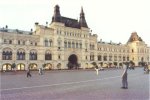 Each
evening I took the 500m or so stroll from the Intourist Hotel
through the pedestrian sub-way to Red Square where I witnessed
the most awesome Northern Hemisphere evening skies imaginable.
The four photos on the left were taken from various vantage points
in the middle of Red Square. I'm going to need to consult
my Encarta encyclopedia to correctly name all the surrounding
buildings of Red Square, but I am 100% confident that the building
in the 3rd photograph is indeed the Kremlin, the central seat
of governmental power in Russia! Each
evening I took the 500m or so stroll from the Intourist Hotel
through the pedestrian sub-way to Red Square where I witnessed
the most awesome Northern Hemisphere evening skies imaginable.
The four photos on the left were taken from various vantage points
in the middle of Red Square. I'm going to need to consult
my Encarta encyclopedia to correctly name all the surrounding
buildings of Red Square, but I am 100% confident that the building
in the 3rd photograph is indeed the Kremlin, the central seat
of governmental power in Russia!
|
|
Probably since the time I first dreamed of flying in a jet fighter
aircraft, at the age of 10 having won a book prize at school and
selected an encyclopedia of the world's most extreme jet fighter
machines, I had played out in my imagination what the actual physical
experience would be like. The flight was going to be quick, we'd
be back on the ground within half-an-hour. Jet fighter/interceptor
planes are not designed for leisurely cruises, only to get into
the sky and close to incoming high-flying aircraft as quickly
as engineering and the laws of nature will allow.
|
|
Due to my planned high-altitude parachute jump plans (Excelsior2K+1)
for sometime in 2001, the suit-procedure was of specific
interest to me. First off I was provided a pair of totally
uncool looking pyjama under-wear things, then in came the
two Russian dresser ladies. They were very attentive
and it was clear they knew exactly what they were doing.
Coming from South Africa, with it's 11 official languages
and some 260 dialects, of which I can understand only two,
it didn't bother me too much as they proceeded to chat away
in Russian throughout the 15 minutes or so it took to lace
up the pressure suit.
|

|
|
Contrary to what I was expecting, the pressure suits was
virtually brand new. Fortunately I happen to have
the exact height and stature for the so-called "one-size-fits-all"
suit, which I suspect is not really true if only because
the suit I had on was a perfect fit.
Already snuggly fitting, the suit is further laced up around
the torso and thighs. "Pipes" lead down
the arms, body and legs which when connected to the aircraft's
pressure control system, inflate at high altitude.
I found the suit tight, but not necessarily overly
uncomfortable, and even managed to answer a call of nature
after the ejection suit training.
At the back of my mind I considered what it would be like
wearing such a suit for 24-hours in a crapped gondola at
120,000 ft.
|

|
|
Had the plane experienced problems above 40,000-ft, it
would have been too dangerous to eject wearing the helmet
and oxygen mask equipment supplied for the flight.
This system supplies a constant stream of oxygen through
the breathing mask, however above 35,000-40,000ft the pressure
becomes too low for the lungs to breathe unaided, hence
the need for full or partial pressure suits in the stratosphere.
I was hugely impressed by the quality of the helmet's visor,
especially at high altitude where there's only 1% left of
the atmosphere to absorb the bright sunlight.
Overall I found the equipment to be in extremely good condition
and as clean as new, a sure sign of professionalism despite
the obvious lack of funds for "nice to have" base
maintenance.
|
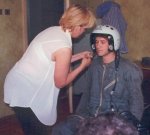
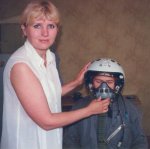
|
|
|
Having participated in sport sky-diving on a rather erratic basis
over the past decade-and-a-half, requiring that I overcome the
mentally challenging "first jump anxiety" every time
I started up again, I realised that unless I focused on relaxing,
the potentially unforgettable memories of the trip would be swamped
out by an excess of adrenaline. As the plane rose from the runway
and continued to accelerate upwards at a steep climbing angle
of 40o, I chose to look out of the left-hand side of
the cock-pit canopy in an attempt to gauge the relative climbing
speed of the Mig against all the commercial jet liners. Well,
there's no contest!
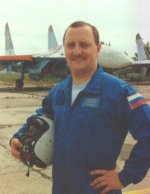
|
Alexandre "Sasha" Garnaev, senior test pilot
at Zhukovsky Flight Research Institute. In the background
is a Mig-29. His father was also a test pilot and relatively
famous poet, an official Hero of Russia.
|
Right after lift-off a loud beeping sound come on over the communications
system built into the helmet, and for the next few seconds the
pilot and a female Russian flight traffic controller swapped a
few sentences. Having just spent some time at the ejection seat
training simulator, the idea that the incessant bleeping was about
to succeeded by an "eject, eject, eject!" command from
Sasha crossed my mind ... and a few seconds later I succumbed,
pressed the mike switch located on my throttle controller and
tried to casually ask "what is that sound?"
|
|
"Boundary marker" responded Sasha. And the plane
continued to climb at what felt like "straight up",
and the only way to keep in synch with the changes in pressure
was to constantly "yawh" ... a type of hard-chinned
yawn ... to clear the pressure build-up in my ears.
After what felt like only a few minutes, Sasha then reported that
we'd now reached 11km in altitude and were about to go through
the sound barrier, and he leveled the Mig out at 11kms for this
process. I'd watched enough Discovery Channel documentaries to
know the going though the sound barrier was not such a big deal
in modern aircraft, but I was surprised when nothing "happened",
or at least nothing that I felt. Various gauges on the cock-pit
dashboard did jump rather violently as they reset for supersonic
avionic measurement, but that was the only indication that we'd
just gone super-sonic.
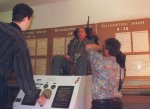 After
suit-up and a pre-flight briefing with my co-pilot, I was
driven around the base to the parachute training block. As promised
in Galina's introductory pack there were dozens of aircraft of
all description parked all around the base, a veritable visual
feast for the extreme machine geek. After
suit-up and a pre-flight briefing with my co-pilot, I was
driven around the base to the parachute training block. As promised
in Galina's introductory pack there were dozens of aircraft of
all description parked all around the base, a veritable visual
feast for the extreme machine geek.
Although the Mig-25 I'd be flying in had a "slaved"
ejection seat system ... meaning that if the instructor pilot
decided to eject, I'd be going with him, like it or not ... the
brief but sufficiently thorough training that I received would
stand me in good stead in most Russian military aircraft, where
the responsibility of carrying out the full ejection procedures
would be mine.
 I
suppose that previous sky-diving and military training helped
me realise the utmost importance of focusing on properly learning
and internalising the emergency ejection drills, so I took the
exercises rather seriously. I
suppose that previous sky-diving and military training helped
me realise the utmost importance of focusing on properly learning
and internalising the emergency ejection drills, so I took the
exercises rather seriously.
But that didn't save me from the surprise of the hydraulic simulator
kicking into action!
|
|
The next stage of the trip introduced a new all-over body experience
to my growing "collection". After leaving all noise
a long way behind the plane, Sasha pulled the plane into a long,
slow climbing turn to the right, a spiral, and turned the power
up to full. For the next minute or two I experienced a constant
4-G "load", a most fascinating feeling and I became
rather mesmerized with the moving my arms around under the gravity
condition four times stronger than normal on Earth's surface.
I would have liked to push for higher Gs, which technically would
have required a tighter turn, so as to get an idea of what I could
handle during the real thing, but I guess the pilots have had
some nasty experiences with "paying" passengers becoming
ill during a flight. Compared to the highly maneuverable Mig-29,
the Mig-25 is not too much more than a very large flying brick,
incapable of doing much more than going extremely fast in a "straight
line".
When I left for Moscow from Johannesburg, swapping over from
a South African Airlines 747-400 plane to an Aeroflot 777, all
I had was a page of printed instructions for arrival in Moscow
and a few contact telephones numbers. I was only staying
2 nights so neglected to purchase a Russian-English dictionary,
figuring that in the absolute worst case I could survive for 3
nights with sign-language and a fistful of US$.
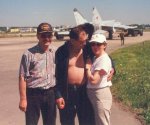 So
I was extremely pleasantly surprised when I was met by a young
Intourist agent at the passport control who whisked me through
customs and delivered me in the care of Galina and Nick, my Russian
hosts representing Incredible Adventures. Galina speaks
near perfect English, albeit with a strong Russian flavoring,
and worked previously as a "science researcher", whatever
that means. Nick is an entrepreneur in the city of Moscow,
doing the best he can to scratch out a living shooting VHS videos
on his old Panasonic prosumer camera. They were both very
courteous and polite and did whatever they could to help me enjoy
my trip, whilst not trying to hide or downplay the obvious problems
created by the state of the Russian economy. So
I was extremely pleasantly surprised when I was met by a young
Intourist agent at the passport control who whisked me through
customs and delivered me in the care of Galina and Nick, my Russian
hosts representing Incredible Adventures. Galina speaks
near perfect English, albeit with a strong Russian flavoring,
and worked previously as a "science researcher", whatever
that means. Nick is an entrepreneur in the city of Moscow,
doing the best he can to scratch out a living shooting VHS videos
on his old Panasonic prosumer camera. They were both very
courteous and polite and did whatever they could to help me enjoy
my trip, whilst not trying to hide or downplay the obvious problems
created by the state of the Russian economy.
The guy with the healthy paunch in the photo is one of the Mig-25
ground crew. Over the years Nick and Galina have fostered a close
friendship with the staff involved in the Mig trips at the Zhukovsky
Flight Research Institute, and this clearly helped keep the entire
itinery running very smoothly.
After passing through the sound barrier, I watched the Mach meter
continue to climb, up through Mach-2 and then onwards towards
Mach-2.8, which was the maximum speed attained through the flight.
As the speed increased, the supersonic friction heat began to
build up, making the cockpit rather uncomfortably hot and long
before we reached peak altitude beads of sweat were beginning
to roll. The sun also grew a lot brighter as we got higher,
and most definitely added to the heat I felt in the cockpit.
Designed in 1958-62, the MiG-25 initial primary
function was to be  the
interception of the American supersonic XB-70 Valkyrie bomber,
and other high-altitude fast-flying aircraft. Though it is large,
heavy, and not at all advanced relative to contemporary
fly-by-wire technologies, the MiG-25 is the fastest interceptor
aircraft of its time. Armed with a powerful long-range radar and
large AAMs, the 'Foxbat' has virtually no capability for close
combat due to its bulky, unmaneuverable airframe. Although the
B-70 was eventually cancelled, production of the MiG-25 went ahead,
and took to the air as the Ye-155R-1 recce prototype on March
6, 1964. A Ye-155P-1 interceptor prototype followed on September
9th of the same year. the
interception of the American supersonic XB-70 Valkyrie bomber,
and other high-altitude fast-flying aircraft. Though it is large,
heavy, and not at all advanced relative to contemporary
fly-by-wire technologies, the MiG-25 is the fastest interceptor
aircraft of its time. Armed with a powerful long-range radar and
large AAMs, the 'Foxbat' has virtually no capability for close
combat due to its bulky, unmaneuverable airframe. Although the
B-70 was eventually cancelled, production of the MiG-25 went ahead,
and took to the air as the Ye-155R-1 recce prototype on March
6, 1964. A Ye-155P-1 interceptor prototype followed on September
9th of the same year.
 The
155R prototype led to the production of the MiG-25R recce variant,
and was followed by the MiG-25RB after being made bomber capable
in 1970. The 155P led to the production of the MiG-25P fighter
with four underwing AAMs. The final MiG-25 interceptor is the
MiG-25PD, and has upgraded engines and more powerful radar over
earlier versions. The
155R prototype led to the production of the MiG-25R recce variant,
and was followed by the MiG-25RB after being made bomber capable
in 1970. The 155P led to the production of the MiG-25P fighter
with four underwing AAMs. The final MiG-25 interceptor is the
MiG-25PD, and has upgraded engines and more powerful radar over
earlier versions.
Mig-25 Tech Vital Statistics
Design Contractor: Mikoyan-Gurevich Design Bureau, Russia
Function: Medium-range interceptor
First flight: 1964
In-service: 1968
Engine: Two Soyuz/Tumansky R-15BD-300 afterburning turbojets,
24,700 lb thrust each
Wing span: 14.02 m / 46 ft
Length: 23.82 m / 78 ft 2 in
Height: 6.1 m / 20 ft
Weight: 44,092 lb empty / 79,807 lb max. take off
Ceiling: 67,900 ft
Speed:
@ altitude: 3,000 km/h / 1,865 mph
@ sea level: 1,200 km/h / 745 mph
Range: 1,730 km / 1,075 miles
|
|
All too soon the long climb upwards was over. Basically the
Mig-25 turbo-jets simply ran out of atmosphere to suck in and
jet out the back, and the feeling of deceleration down from the
peak Mach-2.8 was marked. I was "pulled" forward
into the straps of my seat harness. For a second or two, when
the plane reached absolute peak and tipped over to begin descending,
I felt as if I were on top of the world's biggest roller coaster
.. that lose the stomach feeling, except I was aware of being
"on top of the world" in a really big chunk of machinery.
At 26,100m, the sky is no longer blue but rather a deep black.
Of course this is 2000 and there are now hundreds of pictures
and video clips showing our orbital surrounds, so I had a really
good idea of what to expect. However it felt really special to
be up there in person, knowing that at the specific point in time
I was one of the two highest humans on the planet ... one out
of 6-Billion. For me, it is little "compensations"
like that which make life special and worth going the "extra
few miles, as many as it takes".
 Hoping
to get some video footage from within the cockpit during the flight,
I had purchased a cheap and light Hitachi Super-8 video camcorder
the day before leaving for Moscow. After arriving at the airbase,
the tour driver, Victor, drove the camera off to where the ground
crew were preparing the plane for flight. The camera was
neatly mounted on the dash-board of the instrument panel, but
once I had been fully strapped into the ejection seat I was unable
to reach the record button on the camera .. by a mere few centimeters! Hoping
to get some video footage from within the cockpit during the flight,
I had purchased a cheap and light Hitachi Super-8 video camcorder
the day before leaving for Moscow. After arriving at the airbase,
the tour driver, Victor, drove the camera off to where the ground
crew were preparing the plane for flight. The camera was
neatly mounted on the dash-board of the instrument panel, but
once I had been fully strapped into the ejection seat I was unable
to reach the record button on the camera .. by a mere few centimeters!
Unfortunately the ground crew guy strapping me in could only
speak Russian so I only succeeded in coaching him how to switch
the camera on. Sadly the little Red record button was just
10cms too far away!
|
|
The descent was just as much part of the experience as the ascent.
The constant deceleration of the slowing plane pulling me forward
out of my seat, the reversal of the pressurization and ear-popping
issue ... and a special treat when Sasha suggested I try rolling
the plane. The Mig-25s cock-pit is rather simple and spartan,
no electronic avionics, a fully mechanical aircraft .. EMP proof.
A huge joy-stick, most definitely designed and manufactured in
the 60s, sticks up between the knees. Rolling the Mig is as simple
as firmly pushing the joystick over to the left, no need for any
rudder. After a successful first roll, Sasha then suggested
doing two to the right, which also went well ..and in the process
helped me overcome an innate and long imagined fear of "upside
down" planes. The Mig-25 was made to roll!
Zhukovsky Air Base and The Gromov Flight Research Institute.
From the orientation overview written by Incredible Adventures
Inc. Russia General Manager, Galina Andreeva.
"Your Incredible Adventures high performance flying holiday
will take place in Zhukovsky - a small town located 35km south-east
of Moscow - which has been at the center of Russian aviation throughout
the last 50 years. The town is named for Nikolai Zhukovsky - the
renowned scientist known as the father of Russian aviation."
 "All
of the key aviation research centers in Russia are located in
Zhukovsky. One of them is the Gromov Flight Research Institute
(known by its Russian acronym "LII"), with whom Incredible
Adventures has worked closely since October 1993. Established
in 1941, the Institute has made significant contributions to the
improvement of combat aircraft performance as well as the development
and testing of new and updated aircraft." "All
of the key aviation research centers in Russia are located in
Zhukovsky. One of them is the Gromov Flight Research Institute
(known by its Russian acronym "LII"), with whom Incredible
Adventures has worked closely since October 1993. Established
in 1941, the Institute has made significant contributions to the
improvement of combat aircraft performance as well as the development
and testing of new and updated aircraft."
"Currently, LII is regarded as the premier test center for
aviation engineering and research in Russia. By conducting test
flights on planes, helicopters, flying test-beds and models -
in addition to participating in factory and State testing - the
Flight Research Institute plays an integral role in solving the
numerous problems which face new aircraft and aviation equipment
development. (For example the great deal of flight testing performed
at LII made it possible for the Ilyushin Design Bureau to construct
an air-tanker IL-78 which is capable of re-fueling all types of
in-flight aircraft."
 "The
Institute has a large and unique airfield capable of testing every
type of aircraft available in Russia. The airfield has three
concrete runways, one of which is the longest in Europe. This
particular runway is 120 meters wide, 5.4km in length and has
no weight limitations. (It was on this runway that the carrier
aircraft "Mriya" achieved a successful take-off and
landing while "carrying" the Buran orbiter at a total
weight of 600 metric tons!)" "The
Institute has a large and unique airfield capable of testing every
type of aircraft available in Russia. The airfield has three
concrete runways, one of which is the longest in Europe. This
particular runway is 120 meters wide, 5.4km in length and has
no weight limitations. (It was on this runway that the carrier
aircraft "Mriya" achieved a successful take-off and
landing while "carrying" the Buran orbiter at a total
weight of 600 metric tons!)"
 "The
airfield boasts an aerial flight test zone of 400 by 100km. The
Automated Air Traffic Control System, which includes aerodrome
and surveillance radars (PAR), communications (COM) and radio
navigation aids (NDB, ILS, MLS), serves to reliably control day
or night flights with a level of safety under virtually all meteorological
conditions. The System is augmented by trajectory measurement
as well as a real time experimental data processing system." "The
airfield boasts an aerial flight test zone of 400 by 100km. The
Automated Air Traffic Control System, which includes aerodrome
and surveillance radars (PAR), communications (COM) and radio
navigation aids (NDB, ILS, MLS), serves to reliably control day
or night flights with a level of safety under virtually all meteorological
conditions. The System is augmented by trajectory measurement
as well as a real time experimental data processing system."
Throughout your visit at the Base, you will be able to see a
wide variety of some of Russia's - and the world's - most famous
high performance aircraft: the Mig-21, Mig-23, the high-altitude
and high-speed record holder Mig-25 as well as the internationally
acclaimed Mig-29 and Su-27. Similarly, there is an extensive array
of transport aircraft at the Base, including the IL-76, IL-86
and the "Russian Concord" - the Tu-144, as well as helicopters
such as the MI-2, MI-8, MI-24, KA-32, the world famous "Hind"
KA-50 and the world's largest helicopter, the MI-26.
 While
merely visiting this historic and formerly "closed"
(Top Secret) Base could be considered an exceptional experience
- one which would have been unthinkable even a few years ago -
you are about to have the extraordinary opportunity of actually
flying there in the company of some of the world's most respected
test pilots. As you join us to fly internationally acclaimed high
performance aircraft at the Base which has long been the heart
of Russian aviation, we at Incredible Adventures would like to
wish you an unforgettable experience in which all your flying
dreams come true! While
merely visiting this historic and formerly "closed"
(Top Secret) Base could be considered an exceptional experience
- one which would have been unthinkable even a few years ago -
you are about to have the extraordinary opportunity of actually
flying there in the company of some of the world's most respected
test pilots. As you join us to fly internationally acclaimed high
performance aircraft at the Base which has long been the heart
of Russian aviation, we at Incredible Adventures would like to
wish you an unforgettable experience in which all your flying
dreams come true!
 During
the descent back down to the airbase, I made a point of watching
how the colour of the sky gradually changed from it's deep blackness
back to the familiar blue we're all used to from the ground.
The exercise gave me a deep felt appreciation for the fragility
and sheer smallness of our covering "atmosphere". The
extremely personal, wholly subjectively felt "objective"
observation of our planet's life-sustaining covering envelope,
from within the closed environment of a Mig-25 jet fighter descending
to Earth, made it possible for me to visually imagine a lot of
the atmosphere "leaking" into space during a catastrophic
event, such as a comet plunging into one of the oceans (and landing,
SPLAT!, on the continent of Antarctica?). The physical ride
experienced makes it possible to conceive of such fantastical
ideas in the first place. During
the descent back down to the airbase, I made a point of watching
how the colour of the sky gradually changed from it's deep blackness
back to the familiar blue we're all used to from the ground.
The exercise gave me a deep felt appreciation for the fragility
and sheer smallness of our covering "atmosphere". The
extremely personal, wholly subjectively felt "objective"
observation of our planet's life-sustaining covering envelope,
from within the closed environment of a Mig-25 jet fighter descending
to Earth, made it possible for me to visually imagine a lot of
the atmosphere "leaking" into space during a catastrophic
event, such as a comet plunging into one of the oceans (and landing,
SPLAT!, on the continent of Antarctica?). The physical ride
experienced makes it possible to conceive of such fantastical
ideas in the first place.
 For
a least an hour after the flight I was lost for words, somewhat
dumb-struck. For 27 mins my senses had soaked up high speed
high technology and after the engines of the Mig-25 had wound
down all I could think of to say was "Wow", "awesome"
and "incredible". Repeatably. For
a least an hour after the flight I was lost for words, somewhat
dumb-struck. For 27 mins my senses had soaked up high speed
high technology and after the engines of the Mig-25 had wound
down all I could think of to say was "Wow", "awesome"
and "incredible". Repeatably.
 Sasha,
as cool as a cucumber after the flight surveys his kingdom from
atop the Mig-25. As it turns out, the clear conditions experienced
throughout the flight were in Sasha's words: "unique, absolutely
unique visibility" Sasha,
as cool as a cucumber after the flight surveys his kingdom from
atop the Mig-25. As it turns out, the clear conditions experienced
throughout the flight were in Sasha's words: "unique, absolutely
unique visibility"
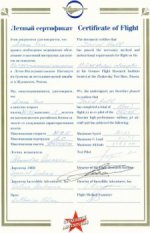 After
the flight, we drove back to the main office building where my
hosts put on a great lunch of traditional Russian "military
research institute" fare in the institute canteen. I don't
recall all the menu items, however the meal was fantastic relative
to the Intourist "hotel" cuisine. After
the flight, we drove back to the main office building where my
hosts put on a great lunch of traditional Russian "military
research institute" fare in the institute canteen. I don't
recall all the menu items, however the meal was fantastic relative
to the Intourist "hotel" cuisine.
After a rather nice impromptu speech by Galina, I was presented
with a "Mig-29" watch, done especially for client of
Incredible Adventures who takes flights in the various Migs.
Not exactly a Sector No-LIMITS, it was very typical of the
cheap mechanical watches with printed cardboard faces of the various
heroes of Russia that I had found at peddlers stands throughout
Moscow. Along with hundreds of military dingbats.
Along with the watch I was given a certificate which provided
the vital statistics of the flight, such as altitude and maximum
g-force. If nothing else, I can prove by certification that
I really did fly to the edge of space!
With it's 5km long runway, and the near perfect visibility of
the day which enabled us to take in a good few hundred thousand
square miles of Russia from peak altitude, I could see the approach
to Zhukovsky around 10kms high and we continued down in a steep
descending "glide", the speed dropping off on the mach
meter to around 0.7. The final treat in store for me was
a fly-over of the run-way at just over 1,000ft, along with an
extremely relative feeling barrel-roll right over the ground crew
and waiting trucks, which came out incredibly well on the "official"
Incredible Adventures video tape of my day's adventures. We then
made a long, low banking turn to return to the bottom of the runway
and on the downwind leg of the approach, Sasha pointed out a little
village alongside the river that lead to Moscow 30km's in the
North. The village had apparently been founded a hundred
years before Moscow itself, back in 1100 or so, so it was a nice
little bonus to see the spot that "started it all" 900
years ago, culminating in a fly-by in one of the world's fastest
jet fighter planes.
After just 27 minutes in the sky, the plane touched down and
coasted back to the waiting ground crew, who rolled up the ladder
and had me out of the cockpit in a few minutes. Was it worth the
$12,000 price tag? The only answer I can think of that makes
any sense to me ... there are some things in life which may be
expensive but which provide a near priceless experience of the
kind which provide value and help create new value for the rest
of one's life. For me, with my very own personal definition
of what success is and it's rewards, this trip was one of those
experiences. I got to see and feel the planet in 3D! I got
to fulfill a boyhood dream that I had promised myself ... if one
cannot keep one's dreams alive, and keep promises to oneself ..
then fantasies for the future are not worth entertaining.
I think they are, so went out and proved it to the only person
that mattered in this particular equation: me! My next party
trick is to somehow make a habit out of striving for and rewarding
myself with meaning-felt adventures such as these!
Postscript: if you think taking a ride in a Mig-25 is "crazy",
then consider this: on the Friday, as I was flying out of
Moscow back to London, in a better hotel around the corner from
the sincerely gross Intourist Hotel in Moscow, American businessman
Dennis Tito announced that he had signed up with MirCorp to train
and visit the Mir space station ... in return for a $20m price-tag.
To my mind this marks the beginning of the privateer space flight
boom that will grow unabated throughout the first decade of the
21st Century!
 On
the evening after the flight, after a long post-flight afternoon
nap, I took a stroll to Red Square ... just in time to capture
the Full Moon rising. In many senses capturing the view of the
Moon, my personal symbol for freedom, in such a dramatic way was
a fitting end to my short trip to Moscow. I've since resolved
to continue capturing Full Moon dawn shots from different spots
around the world, which includes finding a more capable lens. On
the evening after the flight, after a long post-flight afternoon
nap, I took a stroll to Red Square ... just in time to capture
the Full Moon rising. In many senses capturing the view of the
Moon, my personal symbol for freedom, in such a dramatic way was
a fitting end to my short trip to Moscow. I've since resolved
to continue capturing Full Moon dawn shots from different spots
around the world, which includes finding a more capable lens.
|
back
|

